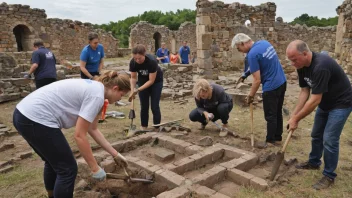As travel restrictions and social distancing measures continue to shape our world, many individuals are seeking meaningful ways to contribute to communities in need, even from afar. In this fictional interview, we sit down with Dr. Sarah Thompson, a renowned expert in humanitarian aid and volunteerism, who shares her insights on finding volunteer opportunities during the pandemic. Dr. Thompson has spent over a decade working with various non-profit organizations across the globe, focusing on community development and crisis response.
Understanding the Impact of the Pandemic on Volunteerism
Interviewer: Dr. Thompson, how has the pandemic affected the landscape of volunteer opportunities?
Dr. Thompson: The pandemic has indeed transformed how we think about volunteering. Traditional in-person volunteer work has been significantly impacted, but this has also led to the emergence of new opportunities. Organizations have had to adapt quickly, utilizing digital tools to connect volunteers with those in need remotely. For instance, many organizations are now offering virtual volunteering roles, which allow individuals to contribute from the safety of their homes.
Finding Opportunities
Interviewer: What are some effective ways for individuals to find volunteer opportunities during this time?
Dr. Thompson: There are several avenues to explore:
- Online Platforms: Websites like VolunteerMatch and Idealist have robust listings of virtual and in-person opportunities.
- Social Media: Many organizations use platforms like Facebook and Instagram to promote volunteer needs. Following local non-profits can help you stay informed.
- Community Boards: Local community centers often have bulletin boards or websites with volunteer opportunities, including those in need of remote support.
- Networking: Engaging with friends or colleagues who are involved in volunteer work can lead to unexpected opportunities. Often, the best leads come from personal connections.
Virtual Volunteering: A New Frontier
Interviewer: Can you elaborate on what virtual volunteering entails and its benefits?
Dr. Thompson: Virtual volunteering can encompass a range of activities, from tutoring students to assisting with administrative tasks for non-profits. The benefits are immense: it allows for a broader reach, meaning volunteers can support causes outside their immediate geographical area. Moreover, it often requires less time commitment, making it accessible for people with busy schedules.
Challenges Faced by Volunteers and Organizations
Interviewer: What challenges do volunteers and organizations face in this new environment?
Dr. Thompson: Communication and engagement can be challenging in virtual settings. Organizations may struggle to keep volunteers motivated and connected. Additionally, volunteers may feel isolated or disconnected from the cause. It's essential for organizations to foster community among volunteers, whether through regular check-ins or virtual gatherings.
The Future of Volunteerism Post-Pandemic
Interviewer: How do you envision the future of volunteerism once the pandemic is behind us?
Dr. Thompson: I believe we'll see a hybrid model of volunteering. In-person opportunities will resume, but many organizations have discovered the value of virtual volunteering and may continue to offer those options. This flexibility will open doors for more people to engage in volunteer work, making the experience more inclusive.
Advice for Aspiring Volunteers
Interviewer: Finally, what advice would you give to someone looking to start volunteering during the pandemic?
Dr. Thompson: I encourage everyone to start by assessing their skills and interests. Think about what you are passionate about and how you can contribute. Don't hesitate to reach out to organizations that resonate with you; they often welcome inquiries from potential volunteers. Remember, even small contributions can make a significant impact.






